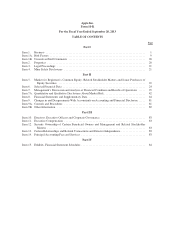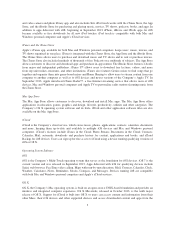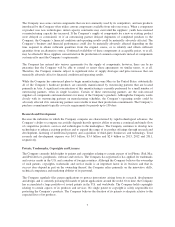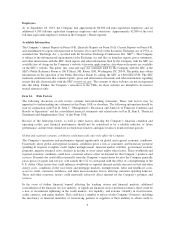Apple 2013 Annual Report Download - page 12
Download and view the complete annual report
Please find page 12 of the 2013 Apple annual report below. You can navigate through the pages in the report by either clicking on the pages listed below, or by using the keyword search tool below to find specific information within the annual report.finance development and/or manufacture products resulting in product delays; inability of customers, including
channel partners, to obtain credit to finance purchases of the Company’s products; failure of derivative
counterparties and other financial institutions; and restricting the Company’s ability to issue new debt. Other
income and expense also could vary materially from expectations depending on gains or losses realized on the
sale or exchange of financial instruments; impairment charges resulting from revaluations of debt and
equity securities and other investments; interest rates; cash balances; volatility in foreign exchange rates; and
changes in fair value of derivative instruments. Increased volatility in the financial markets and overall
economic uncertainty would increase the risk of the actual amounts realized in the future on the Company’s
financial instruments differing significantly from the fair values currently assigned to them.
Global markets for the Company’s products and services are highly competitive and subject to rapid
technological change, and the Company may be unable to compete effectively in these markets.
The Company’s products and services compete in highly competitive global markets characterized by aggressive
price cutting and resulting downward pressure on gross margins, frequent introduction of new products, short
product life cycles, evolving industry standards, continual improvement in product price/performance
characteristics, rapid adoption of technological and product advancements by competitors, and price sensitivity
on the part of consumers.
The Company’s ability to compete successfully depends heavily on its ability to ensure a continuing and timely
introduction of innovative new products and technologies to the marketplace. The Company believes it is unique
in that it designs and develops nearly the entire solution for its products, including the hardware, operating
system, numerous software applications, and related services. As a result, the Company must make significant
investments in research and development. The Company currently holds a significant number of patents and
copyrights and has registered and/or has applied to register numerous patents, trademarks and service marks. In
contrast, many of the Company’s competitors seek to compete primarily through aggressive pricing and very low
cost structures, and emulating the Company’s products and infringing on its intellectual property. If the Company
is unable to continue to develop and sell innovative new products with attractive margins or if competitors
infringe on the Company’s intellectual property, the Company’s ability to maintain a competitive advantage
could be adversely affected.
The Company markets certain mobile communication and media devices based on the iOS mobile operating
system and also markets related third-party digital content and applications. The Company faces substantial
competition in these markets from companies that have significant technical, marketing, distribution and other
resources, as well as established hardware, software and digital content supplier relationships; and the Company
has a minority market share in the smartphone market. Additionally, the Company faces significant price
competition as competitors reduce their selling prices and attempt to imitate the Company’s product features and
applications within their own products or, alternatively, collaborate with each other to offer solutions that are
more competitive than those they currently offer. The Company also competes with illegitimate ways to obtain
third-party digital content and applications. Some of the Company’s competitors have greater experience,
product breadth and distribution channels than the Company. Because some current and potential competitors
have substantial resources and/or experience and a lower cost structure, they may be able to provide products and
services at little or no profit or even at a loss. The Company also expects competition to intensify as competitors
attempt to imitate the Company’s approach to providing components seamlessly within their individual offerings
or work collaboratively to offer integrated solutions. The Company’s financial condition and operating results
depend substantially on the Company’s ability to continually improve iOS and iOS devices in order to maintain
their functional and design advantages.
The Company is the only authorized maker of hardware using OS X, which has a minority market share in the
personal computer market. This market is dominated by computer makers using competing operating systems,
most notably Windows. In the market for personal computers and peripherals, the Company faces a significant
number of competitors, many of which have broader product lines, lower priced products, and a larger installed
10
























